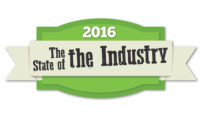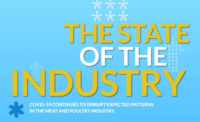The meat and poultry industry has been a lot like the weather of late: As soon as you have it figured out, it changes.
Although many would like to think the industry is in better shape this year than last year, it’s really just different. Yet change is inevitable, and staying on top of these nuances is key to moving ahead successfully. The factors that come into play for future prosperity are not just the staples of the past — supply and demand, feed ingredients — but include newer influences such as the changing global environment and consumer whims.
Long term, the future is bright. The populations of the BRICS countries (Brazil, Russia, India, China and South Africa) are going to want to eat a lot more protein as they earn more money. As of 2015, the five BRICS countries represent more than 3 billion people, or 42 percent of the world population. Predictions indicate BRICS will dramatically increase their gross domestic product in the next five years. As their populations gain income, they will most certainly demand additional protein supplies. Our industry will have the opportunity to help these countries by providing the supply necessary to satisfy their future demand.
The USDA report from July 24, 2015, shows beef cow inventories were up 3 percent from one year ago, at 30.5 million. This continues a slow recovery from herd reduction sparked by the drought of 2012, in which family farmers concentrated on corn and soybeans, abandoning cattle as a secondary means of income. Combined meat and poultry production in the U.S. is growing at its fastest pace in four decades and is expected to hit a record near 95 billion pounds this year.
Supply of pork and broilers, measured on a per-capita basis, is expected to grow by 6 percent each this year, while per-capita beef supplies will stay flat. The three protein sources, which account for 92 percent of U.S. meat consumption, are rising 4 percent on a combined per-capita basis, the biggest annual gain since 1976. Growth in pork and poultry supplies are expected to level off soon, but the rebuilding of cattle herds now underway points to a big surge in beef supplies by 2017. According to Trevor Amen, an economist with CoBank’s Knowledge Exchange Division, “This abundance of supply will be reflected in an erosion of meat prices over the next two years.”
The feared outbreak of bird flu hit the Midwest U.S. this spring and early summer. While this occurrence was a geographical event with producers in Iowa and Minnesota both getting hit very hard, a significant de-population of birds occurred in both the turkey business and the egg industry. Fortunately for the broiler business, there was minimal impact because there is only one major broiler producer in the affected areas. Bird population recovery in the egg business could take 12 to 18 months and a minimum of 6 to 9 months in the turkey business.
Consumer trends continue to affect the business in myriad ways. The number of consumers reportedly switching to vegetarian diets in the past couple years reflects a troublesome trend, and producers who don’t adjust production could find themselves exposed in a market that can’t seem to find its balance. Additionally, activists continue to influence the industry and its customers. Following General Mills’ and Nestle’s lead, McDonalds announced on Sept. 8, 2015, that within 10 years it will purchase cage-free eggs only, as consumers find the “cage free” label appealing. This means 90 percent of today’s henhouses will need to adapt to fit the requirements by the large egg buyers, turning their traditional old-style cages into colony-enriched cages or cage-free environments. Yet, despite the variety of ways consumers influence the business, the per capita disappearance of red meat and poultry by consumers in the U.S. continues to rise.
Politics will continue to affect our industry. 2016 is an election year, and we’re burdened with people in power who have a limited understanding, if any, of how food is produced. Over-regulation will continue to be a barrier to progress in our industry. The Environmental Protection Agency’s intent on redefining the Clean Water Act, classifying every mud puddle into a waterway so the agency can regulate it, is a major issue. Farmers and everyone in agriculture need to continue to fight it.
Country of Origin Labeling (COOL) legislation continues to cause controversy between the U.S. and other North American countries. Canada and Mexico are scheduled to have the World Trade Organization (WTO) serve as the arbitrator of the hearings, and the U.S. has already lost several disputes. On May 18, 2015, the WTO stated, “Requirements for beef and pork are unavoidably discriminatory,” and in June, the U.S. Congress approved a bill to repeal COOL labeling for beef, pork and chicken.
Maintaining control of components of our industry (petroleum, feed ingredients, cost-effective labor and more) continue to pose a challenge as these items represent a significant portion our cost structure. While the U.S. is the most cost-effective country in the world for growing crops, the increased yield in bushels per acre of crops (soybeans, wheat and corn) has resulted in the current glut that is driving prices down and creating inexpensive feed ingredients. Whereas the U.S. preferred feed ingredient is corn, many other parts of the world prefer wheat as their feed ingredient because of availability. With all these commodities being major cost components of protein production, cost of goods should be favorable for the industry moving forward.
Labor cost in the U.S. continues to rise, and because of the higher labor costs, the U.S. is not the leader in many industries. Labor cost represents the No. 2 cost component to most protein producers.
If the U.S. can avoid being sucked into the worldwide recession and producers can control supply, this could be a fairly favorable year for the protein industry. The U.S. is very competitive at growing animal protein with our inspection laws and freight costs protecting U.S. suppliers from imports of chicken, pork and beef.
In conclusion, a continuing trend toward consolidation will be essential. With the market continuing to change, only the strongest players will continue to thrive. There is no predicted relief from the government meddling in our business, so our industry will have to continue to improve our efficiency through enterprising innovation. We need to continue to moderate supply so we are not faced with a surplus, causing a reduction in price. The future is only as bright as we make it. NP
State of the Industry 2015 segments
| Industry overview | Goes live Oct. 6 |
| Food Safety | Oct. 7 |
| Packaging | Oct. 8 |
| Beef (NCBA) | Oct. 9 |
| Beef (CAB) | Oct. 12 |
| Pork | Oct. 13 |
| Chicken | Oct. 14 |
| Turkey | Oct. 15 |
| Veal | Oct. 16 |
| Lamb | Oct. 19 |









Report Abusive Comment